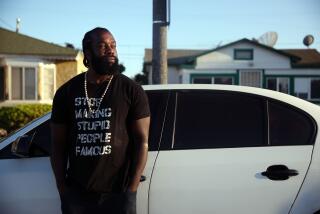Op-Ed: Why a car-centric transportation plan is folly for L.A.
- Share via
The knock on L.A.’s Mobility Plan 2035 is that it will slow down traffic. After the City Council approved the blueprint, the community group Fix the City wrote that “MP2035 is not a mobility plan, it is a plan designed to create immobility.” It has a point. The city wants to redesign several thoroughfares to accommodate bikes and buses. As a result, grades for some streets’ “level of service” — the flow of automobile traffic — are likely to fall.
Here’s the thing: Mobility, in the form of faster vehicle operating speed, isn’t the key to a superior transportation system.
After more than 40 years as a transportation engineer, I’m very aware that most of the traditional measures of transportation efficiency focus on mobility, often expressed as “delay per capita” or “dollars wasted while waiting in traffic.” But what really matters is access.
Access — to shopping or work — can be improved by increasing the speed with which we travel between destinations or by decreasing the distance separating them. But we have to choose. Mobility and proximity are in combat with one another. The more mobility we create, the more distant destinations grow — because free-flowing traffic encourages sprawl. The closer destinations are to one another, the slower transportation gets — because density leads to congestion.
Which choice is superior?
In 2012, a team of researchers at the University of Michigan published a study that compared speed to proximity in 38 U.S. metropolitan areas. The initial results were ambiguous. Houston, for example, bested Philadelphia on average speed but lost on proximity. Los Angeles lost to New York on both speed and proximity.
Overall, however, the study concluded that the value of increased proximity is roughly 10 times as important in improving accessibility as its cost in reduced speed. Put another way, it’s 10 times more efficient, in economic terms, to shorten the distance separating home from work (or home from supermarket) than to increase the speed at which it’s possible to travel from one to the other.
Consider two families. One lives in a walkable neighborhood. To get to the nearest drugstore, half a mile away, they could take a three-minute drive or a 10-minute walk. The other family lives in an auto-centric area where the nearest drugstore is five miles away. When the roads are clear, it takes 15 minutes to drive there. The second family has greater mobility; its members travel each mile faster. The first, though, has superior access. Closer beats faster.
There’s no reason to believe that mobility drives prosperity. On the contrary, throughout the developed world, higher mobility is correlated with a lower gross domestic product, while “inefficient” roads, in terms of vehicle speed, tend to serve economically productive areas.
Another study, this one from Texas A&M, found that for every 10% increase in traffic delays, per-capita GDP increased 3.4 %. This doesn’t mean that lower mobility directly enhances economic productivity, but it does suggest that places with a lot of congestion are more economically vibrant than those without.
And that seems to be an eternal relationship. Last year, a group of anthropologists found that density-fueled congestion, as measured by population per street mile, was powerfully associated with prosperity in the ancient cities of pre-Columbian Mexico (though the prosperity of the 4,000 archaeological sites was measured in monument building and house size rather than GDP). Congestion implies more, and more frequent, social interactions, and social interactions are essential for all forms of productivity, from harvesting crops to selling razor blades to performing music.
So if Mobility Plan 2035 will slow down traffic, that’s worth applauding. To the degree that it will increase the presence of bicycles and pedestrians on Los Angeles’ streets, it promises to be a “mobility” plan that actually promotes access. By making a commitment to transportation alternatives — walking and cycling — Los Angeles, once the archetype for automobile dependence, has bound itself to a new kind of urban model.
Sam Schwartz has served as New York City’s traffic commissioner and the New York City Department of Transportation’s chief engineer. He is the author, with William Rosen, of “Street Smart: The Rise of Cities and the Fall of Cars.”
Follow the Opinion section on Twitter @latimesopinion and Facebook
More to Read
A cure for the common opinion
Get thought-provoking perspectives with our weekly newsletter.
You may occasionally receive promotional content from the Los Angeles Times.










